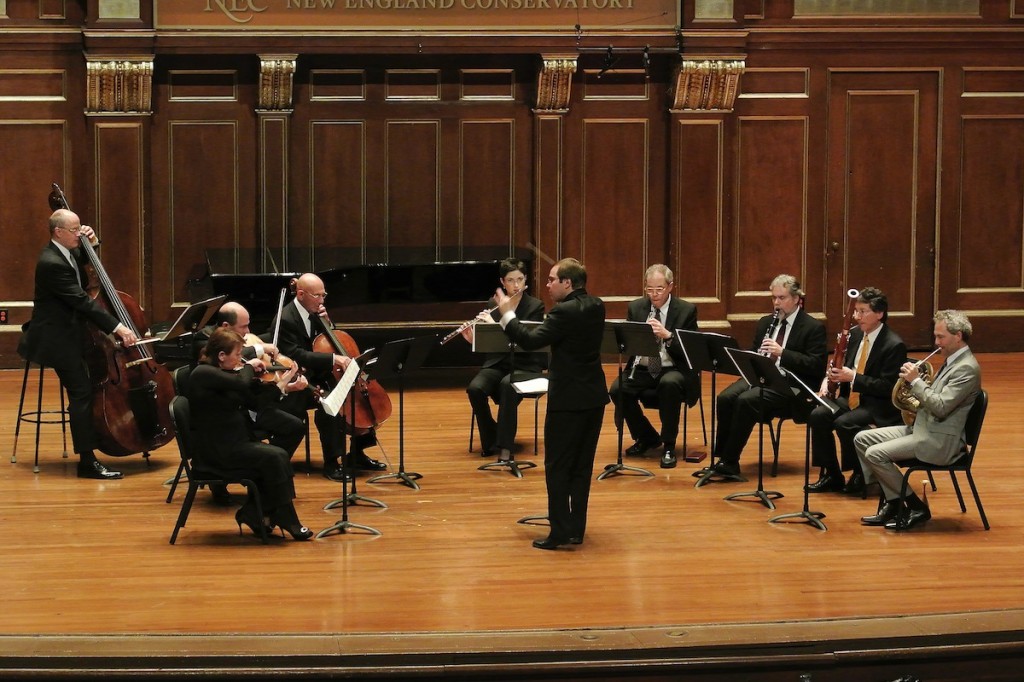Boston Symphony Chamber Players explore far-flung roots in folkloric program

Marcelo Lehninger conducts the Boston Symphony Chamber Players in Lutoslawski’s “Dance Preludes” Sunday at Jordan Hall. Photo: Stu Rosner
Folkloric traditions in bold transformation formed the musical subject of the Boston Symphony Chamber Players program Sunday afternoon at Jordan Hall. The composers were Witold Lutoslawski, Gabriela Lena Frank and Aaron Copland, investigating respectively their Polish, Peruvian and American roots.
Lutoslawki’s Dance Preludes dates from the 1950s, in three separate arrangements for various chamber configurations. The Chamber Players offered the last version, a 1959 nonet for winds and strings, which also required the services of conductor Marcelo Lehninger because of its complex entrances and cross-talking rhythms.
The hint of Bartok was everywhere: the abrupt but rich melodic snippets; asymmetrical phrasing, with overlapping textures moving throughout the ensemble; and the strong feeling that there was an original vernacular lurking somewhere deep within. Five short movements alternated fast and slow tempos.
Brief but expansive, the stately Andantino and Andante sections held the most interest. The Andante had the off-kilter feel of a wandering conversation; strings set a pizzicato base against the winds, with flutist Elizabeth Rowe and oboist John Ferrillo weaving a soft melodic line. The winds and strings played in juxtaposition, a tension that was relieved by the strings abandoning the pizzicato for a drone accompaniment at the climax. A bright melodic figure in the final movement (Allegro molto), again featuring Rowe and Ferrillo, brought the dances to a smart conclusion.
Frank’s Sueños de Chambi, set for flute (Rowe) and piano (guest Jonathan Bass), draws its structure and inspiration from seven photos by the documentary photographer Martin Chambi, who realistically captured the lives of native Peruvian peoples much the way Edward Curtis documented the Native American west.
Frank, American-born but with a widely diverse heritage that includes a Peruvian-Chinese mother, chose seven disparate works (from the tens of thousands that Chambi created) for her settings. While the original photos (described variously as dance scenes, a child’s funeral, a self-portrait of Chambi, among others) had little in common, the music had a through-composed feel. Rowe worked both flute and alto flute, the lower-registered instrument intentionally imitating the native Peruvian quena. Jazzy figures predominated in the piano, except for one solo movement for keyboard, a solemnly romantic dirge (the “funeral” photo).
The playing was sharp, alert to humorous possibilities, and the material simple, in tribute to its native origins. Overall the work seemed overlong for its musical ideas, but might make a stronger impression with repeated listening.
Repeat listenings bring repeated joys when the subject is Copland’s Appalachian Spring, performed here in the original version for 13 players. BSO principals were joined by their deskmate associates, with Bass again sitting in and Lehninger returning to conduct, a tribute not only to the larger-than-usual ensemble but to the music’s challenging rhythmic complexity.
The expansive voice, identifiable sonic space and textures, and accessible melodies of Copland’s great ballet score have the virtue of simplicity without the defect of being blandly sentimental. Even the famous Shaker tune “Simple Gifts” is worked through various guises with a legato variation, a staccato variation and a forte bravura essay.
Rowe, who played a principal part in nearly all the afternoon’s music, and Ferrillo dominated the top voices with the central melodic ideas, but the silken string playing truly created the swell of emotion. Lehninger, now in his third season as BSO assistant conductor, has previously earned the entire orchestra’s confidence, and that translated into an assured and understated rendering here with a smaller ensemble. The group’s work was crisp and entirely enjoyable—and the players’ joy in performing this work was evident throughout as well.
Posted in Performances




